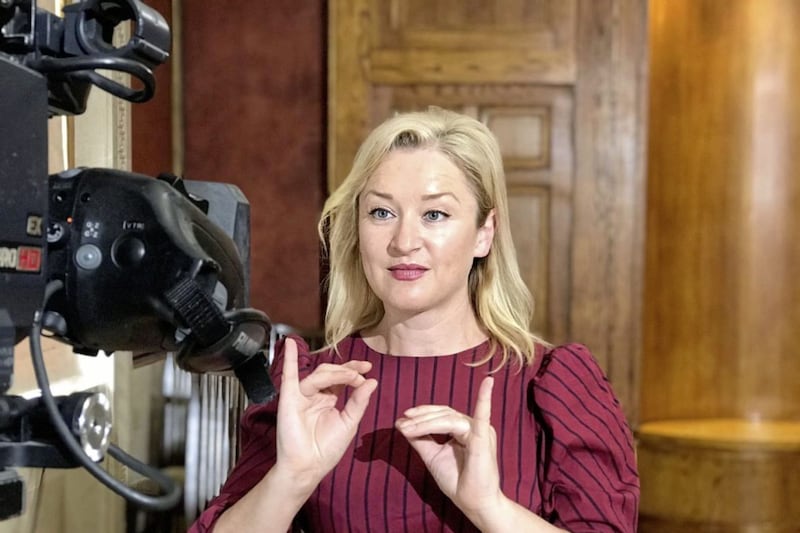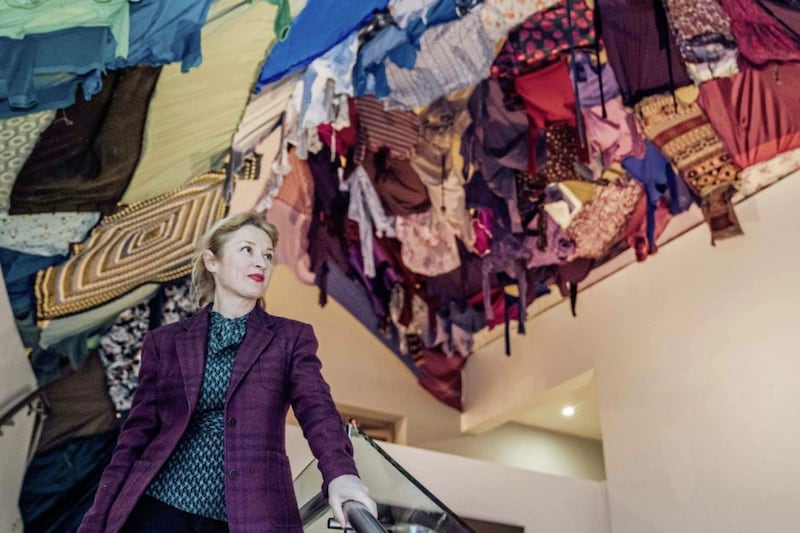It is a long, theatrical leap from the stage of a musical in Dublin to daily news briefings at Stormont and, for once, Amanda Coogan was lost for words.
The ISL (Irish Sign Language) interpreter, who now stands alongside our first and deputy first ministers – as well as her BSL (British Sign Language) counterpart Kristina Sinclair – was not perplexed at the sight of the TV cameras, nor nervous at the thought of the massive TV audiences waiting at the other side. It was the brand new language that we were all grappling with in March that was causing her headaches.
How to translate the concept of ‘lockdown’, for instance, or the ‘R rate’ and ‘social distancing’? There were no literal signs to adequately convey these new terms for the deaf community, who needed to understand their significance for everyday life just as readily as the hearing population.
"Like any language, if I – verbatim – translated the terms, 'social distancing' into French or German, it wouldn't exactly make sense," explains Amanda, who was signing for Blood Brothers on the stage of Dublin's Bord Gáis theatre just before Covid-19 brought the curtain crashing down on live theatre and virtually everything else.
"You have to translate the concept and then make it appropriate in the language. It was an extremely intense time back in March, and we were going, ‘What? What the heck is that: households, lockdown? We’re locking you into your own homes? We can’t literally translate that.
“I can tell, you, we were online a lot and, in the end, we went back to the deaf community for help with the appropriate signs to say what it all meant in practical terms. It was deaf people owning their own language, so I would just take a lead from them.”
The day she took up her new job as ISL sign language interpreter at Stormont was on ‘Lockdown Day’ – March 23 – but as restrictions ease, communicating the updates has become easier with the initial terminology now in place.
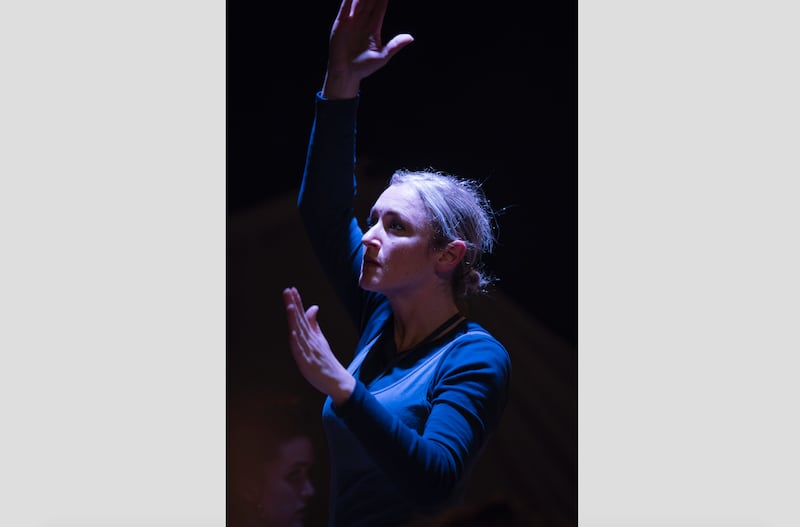
“Interpreting for the daily briefings has been wonderful because this goes beyond politics and even beyond the recognition of sign language itself,” Amanda enthuses from her home in Belfast which she shares with husband Jimmy Fay – executive and artistic producer of the Lyric Theatre – and 13-year-old son Daniel.
“It was about dispensing critical information to more than 4,000 BSL users and around 1,500 ISL users in Northern Ireland. You can imagine, if there are several thousand deaf people walking around, not understanding the rules at the start of lockdown, that would be dangerous for us all.”
It is also, perhaps, a sign of the times and the increased importance being placed on sign language per se that the Stormont Executive had been discussing a sign language recognition bill before the pandemic took hold. Such a development would, say supporters, bring huge benefits to sign language users across the north, helping with communication, information and vital access to services.
A celebrated and award-winning performance artist (and teacher), Amanda has managed to run both her artistic and interpreter careers in parallel and says she is proud to call herself a CODA – Child of Deaf Adults.
With both parents deaf, sign language quickly became her first language and, looking back, the now 48-year-old says it was “a very rich experience” growing up in an “active” deaf community in Dublin.
“At one point, my dad was the president of the Irish Deaf Sports Association, so we were always in a club or on the sports field and there was always signing,” she says. “Most deaf people marry another deaf person – and that is all about communication – but most deaf couples have hearing children and my brother, sister and I can all hear.
“We signed at home – that was the language of the house – and I communicated with my parents through my body; it’s a beautifully dynamic, descriptive language and it was a beautiful, visual world that I lived in.”
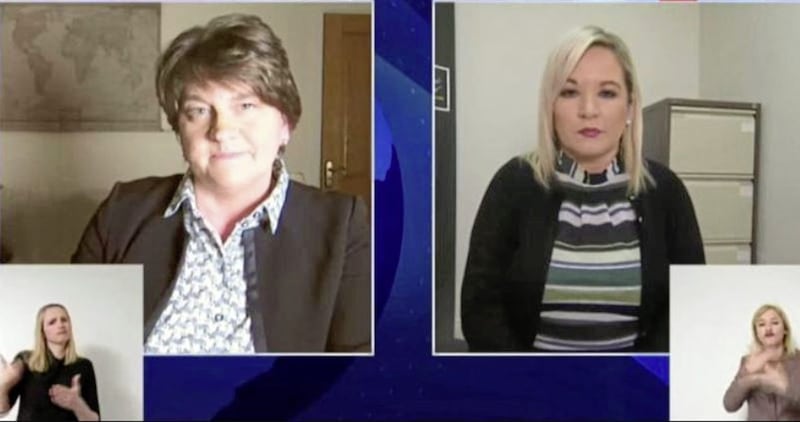
Art college beckoned in Limerick and after graduating in Fine Art, Amanda returned to Dublin and set up a little studio at home.
“About that time, members of the deaf community would knock on my door and ask, ‘Would you just come along to this meeting or that meeting and tell us what the person is saying...” recalls the artist, who also studied sculpture in Dublin, gained a master’s degree through working with renowned performance artist Marina Abramovic, in Germany, and obtained a Phd in Fine Art Performance from Ulster University in Belfast.
“I said, ‘yes’ of course, and that is how the interpreting started. There were no qualified sign language interpreters in Ireland in the early 90s, so I went through lots of training, assessments and registration so I could develop this career alongside my career as an artist. I felt very blessed to have been able to do both.”
She trained in ISL at Trinity College, Dublin, becoming one of the first to qualify as a professional interpreter, while simultaneously making a name for herself in the specialised world of performance art.
“I’m still very much a visual artist and exhibit in galleries and museums all the time,” she reflects. “Watercolour and Indian ink are my go-to materials, and I do love to spill some coffee which creates a beautiful brown and does funny things on paper...
“I will also incorporate signing gestures into some of my live performances and one time, somebody asked me if I was an ‘accessible’ artist. I said, ‘No’, my art is just a hotch-potch of everything!”
Often, her two passions collide, as with an exciting new 250th celebratory Beethoven project with the Dublin Theatre of the Deaf. “We were going to translate [deaf composer] Beethoven’s 9th Symphony and put it to movement – maybe a dance,” Amanda reveals, declaring herself “totally heartbroken” that it has been put on hold due to Covid-19.
But, if lockdown has taught us anything, she insists, it is the importance of the arts for our mental health – something that she saw at first hand during her recent ‘artist-in-residence’ stint at The Millennium Court Arts Centre in Portadown where she created an installation exhibit based on older people’s memories of ‘This Place’.
“I think the lockdown has been really interesting in how we have all turned to art,” she says, “how we have gained solace from music, books and poetry... and how important that all is for mental health. I think we need to invest in the arts more now so we have them still in the future.”
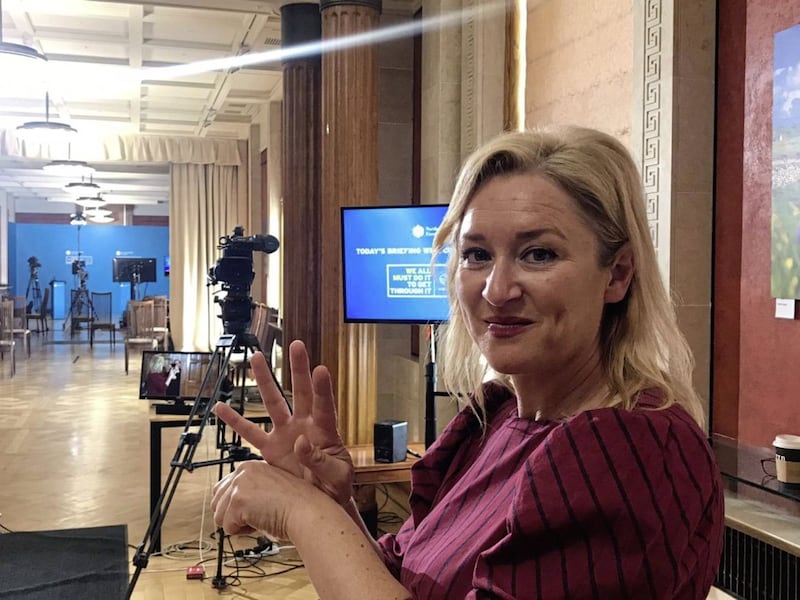
While still signing at Stormont three afternoons a week, Amanda continues to pursue her own artistic path and was recently awarded the Markievicz Award from the Irish government – named in honour of republican leader and first female MP Constance Markievicz, herself an artist – this year supporting artists to produce new work reflecting on the role of women in Ireland as part of its Decade of Centenaries initiative.
The chosen topic is the position held by deaf women in society 100 years ago.
“I just want to uncover personal stories – that is always what is important to me," Amanda says of her plans for the project. "I am not interested in what I can read in a history book. I can do that kind of research in the library very easily.”



